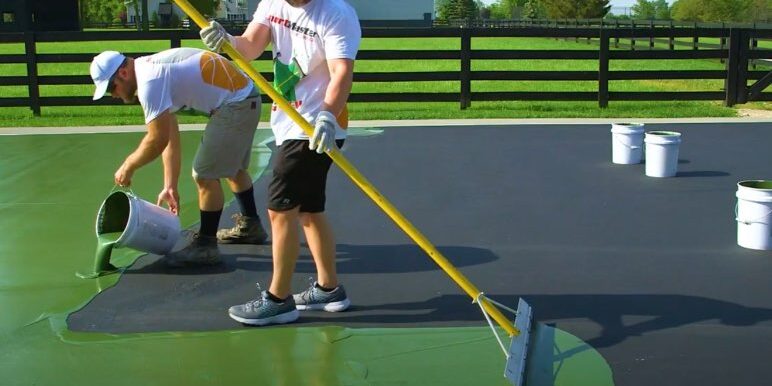Budget Friendly Pickleball Court Construction for Homes and Communities
Budget Friendly Pickleball Court Construction for Homes and Communities
Blog Article
Lasting Practices in Pickleball Court Building You Ought To Know
As the appeal of pickleball remains to climb, so too does the need for lasting techniques in court construction. This approach not only addresses ecological worries however also enhances the durability and capability of the courts. From selecting green materials to implementing efficient drain and energy-saving lighting solutions, there are many strategies to take into consideration. The impact of these practices prolongs far beyond the court itself. Comprehending just how each component contributes to a more sustainable future welcomes additionally expedition into the elaborate balance between leisure development and ecological stewardship.
Picking Eco-Friendly Products
Selecting green products is a crucial action in the building and construction of sustainable pickleball courts. The option of lasting materials not just minimizes environmental impact however additionally improves the long life and efficiency of the court. Key materials include recycled rubber for the surface area, which uses superb longevity and shock absorption while diverting waste from land fills.
Additionally, using in your area sourced products reduces transportation emissions and sustains regional economic situations. Pickleball court construction. For instance, using native hardwoods for fencing and seating can supply a lasting visual while making certain strength against the aspects.
Integrating permeable products for court structures can further add to sustainability by allowing for natural water drainage and reducing drainage. These options not just protect local communities but additionally advertise much healthier play atmospheres.
Reliable Water Drainage Solutions
While the selection of environment-friendly products is important, implementing effective water drainage options is similarly vital for preserving lasting pickleball courts. Appropriate drain not only secures the court surface area from water damage yet also minimizes erosion and runoff, advertising ecological honesty.
Effective water drainage systems can include permeable paving, which permits water to infiltrate the ground instead of pooling on the surface. This lowers the chance of standing water, which can cause mold and mildew and other maintenance concerns. Furthermore, including strategically put drain networks and swales can direct excess water far from the court location, making sure a completely dry playing surface and avoiding dirt erosion.
Making use of indigenous greenery in the landscape design around the courts can even more improve water drainage by soaking up excess water and lowering drainage. These plants need much less irrigation and promote biodiversity, aligning with lasting methods.
Additionally, it is essential to frequently preserve the drainage system to guarantee its long-term effectiveness. This includes clearing debris and monitoring for clogs. By prioritizing efficient drain remedies, pickleball court manufacturers can considerably add to the sustainability and durability of the center, inevitably benefiting both players and the atmosphere.
Energy-Efficient Lights Options
As the demand for pickleball remains to expand, incorporating energy-efficient lighting alternatives into court style has come to be progressively important for sustainability. Typical lights systems usually take in too much power, adding to greater functional prices and ecological influence. Consequently, embracing modern, energy-efficient technologies is vital for more tips here both new constructions and restorations.
LED (Light Emitting Diode) illumination stands out as a top choice because of its durability and energy financial savings (Pickleball court construction). Contrasted to standard lights, LEDs use about 75% less power and can last approximately 25 times much longer, substantially minimizing upkeep prices. Moreover, the directional nature of LED lights decreases light pollution, making sure that lighting is concentrated on the court as opposed to surrounding areas.

Lasting Surface Area Alternatives
Discovering lasting surface area alternatives for pickleball courts has actually gotten traction amongst contractors and players alike. The focus on environmentally friendly products not important site only aligns with the growing environmental awareness however additionally enhances the efficiency and toughness of the courts.
One prominent alternative is using recycled rubber, which can be sourced from used tires. This product provides superb shock absorption, minimizing the threat of injuries for gamers while promoting sustainability. Furthermore, modular floor tiles made from recycled plastics use one more sensible option. These ceramic tiles are very easy to set up and replace, and their versatility enables various court configurations.
All-natural grass courts are additionally arising as a lasting option, promoting biodiversity and reducing the heat island result. However, they require normal upkeep and water, which might not straighten with all sustainability goals.

Water Preservation Methods

An additional efficient strategy entails the installation of rainwater harvesting systems. These systems collect and save rain for usage in maintaining court surface areas and landscaping. This approach not only preserves drinkable water but also lowers reliance on local resources.
Additionally, using drought-resistant landscaping around the courts is crucial. Indigenous plants call for much less water and are much better adjusted to regional climate problems, therefore reducing general water usage. Additionally, making reference use of reliable irrigation systems, such as drip irrigation, guarantees that water is supplied straight to plant origins, reducing dissipation and waste.
Conclusion
Incorporating sustainable methods in pickleball court building and construction considerably contributes to ecological preservation and resource efficiency. Using green materials, implementing efficient drain services, and embracing energy-efficient lights options can significantly minimize eco-friendly influence. Checking out sustainable surface area choices and employing water conservation methods improve the total sustainability of these entertainment facilities. By prioritizing these practices, the construction of pickleball courts can align with wider environmental objectives while promoting durability and performance within areas.
As the appeal of pickleball continues to increase, so too does the need for sustainable methods in court building and construction.Picking environment-friendly materials is a vital step in the building and construction of sustainable pickleball courts. By prioritizing energy-efficient lights options, pickleball court manufacturers can add to an extra sustainable future while fulfilling the needs of stakeholders and gamers alike.Including sustainable surface choices not only improves the efficiency of pickleball courts however likewise leads the way for implementing reliable water conservation strategies.Incorporating lasting practices in pickleball court construction dramatically adds to ecological preservation and resource efficiency.
Report this page